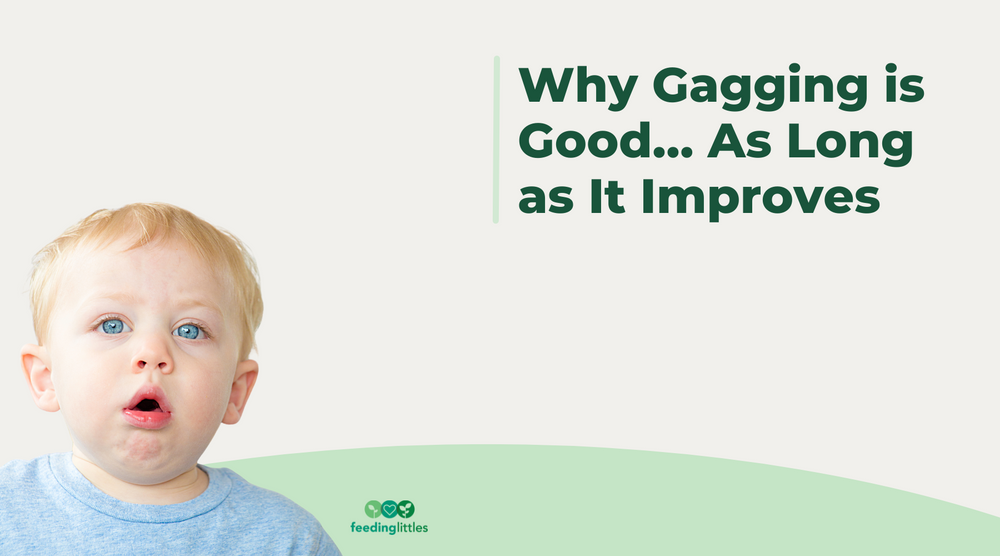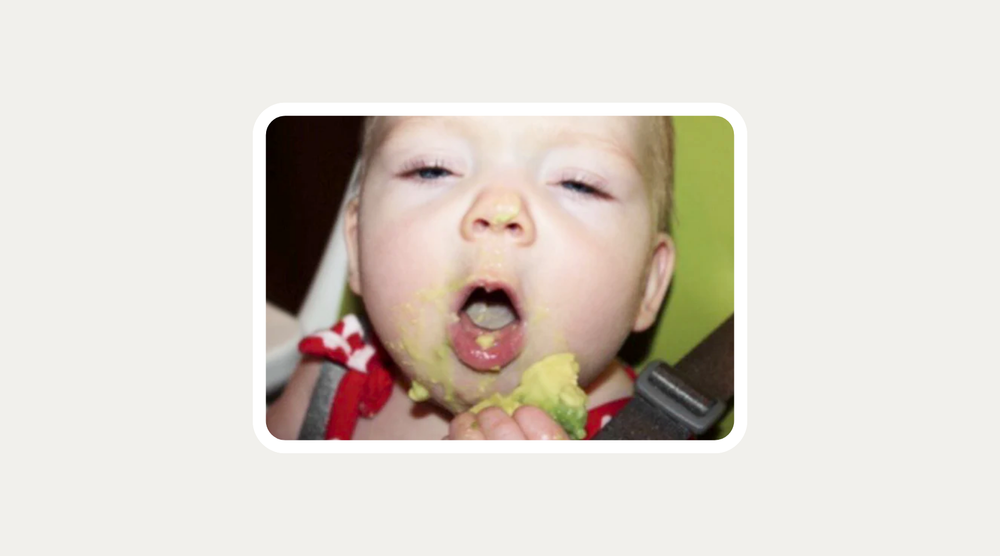
What is gagging, why is it expected, and what can we do if it's not getting better? Read on.
Let’s talk about the biggest source of stress for parents when they start Baby-led Weaning (BLW): safety and gagging. Baby-led Weaning involves offering babies soft finger foods that they can pick up, bring to their mouth and eventually chew and swallow. Parents' biggest fear is that finger foods will cause their baby to choke. This is a very real concern, especially since so many of us are only familiar with seeing babies eat pureed baby foods.
However, what's much more likely to happen when babies start Baby-led Weaning? They will gag. Like, a lot. There are some things we can do to help - keep reading.

Major governing bodies and health associations have always recommended offering finger foods around 6-7 months of age, and a recent study suggested that BLW does not increase risk of choking over spoon feeding, as long as choking hazard foods like whole grapes and whole nuts aren’t offered. However, it doesn’t stop parents from being concerned about safety, since most of us are not comfortable with watching a baby gag.
Please know this: gagging is not the same as choking. In fact, gagging is good because it means that your baby’s body is automatically protecting their airway. You will know baby is gagging and not choking if you can hear sound and if baby is working the food out quickly. Choking does not involve sound (no air = no sound).
Most babies gag frequently for a few weeks when starting BLW. Fortunately, as they get more proficient at bringing the food to the side of their mouths to chew it before swallowing, gagging greatly reduces. Essentially, as your baby practices and learns that they cannot just swallow whole food, they will gag less as and lateralize/chew more. The more gagging and practicing they do, the less they will gag in the long run.
Instead of fearing the gag reflex, we want to teach you more about what it is, how it protects your child, and how to help your baby learn to chew safely. Our Infant Course goes into even more detail about gagging and shows you multiple videos of what it looks like!
Coughing and gagging are similar.
Did you know that gagging is considered one of two oral protective mechanisms? The other such mechanism is coughing. So, your baby protects their airway by coughing or by gagging.
Your baby will cough reflexively after the following things occur:
- Foreign material enters the upper airway. This stimulates the laryngeal receptors, which triggers a cough to expel the foreign material and protect the airway. This happens with most infants daily as they learn to coordinate their breast or bottle skills.
- The bronchial receptors are stimulated by excessive secretions, such as mucous. This is obvious when an infant catches a cold or swallows water during bath time.
Gagging is a good thing.
We are very comfortable seeing our baby cough, since most of us cough at some point during the day. Gagging, on the other hand, seems much scarier because we assume that it means the baby is choking on food.
Remember, gagging is not the same as choking. Furthermore, gagging is simply a protective oral reflex, just like a cough!
The purpose of the gag reflex is to protect the baby from ingesting items too large to be handled by the esophagus. Think of it like a gate keeper – NONE SHALL PASS!
When a baby gags, food comes further forward in their mouth instead of down their throat.Gagging is good because it keeps your baby from swallowing something unsafe for their esophagus. You'll see the food come further forward on their tongue, and they'll either spit it out or keep trying to chew it.
Gagging usually doesn't bother babies. It's should be pretty quick, and babies tend to keep eating while periodically gagging, especially at the beginning of offering solid foods.
To see multiple videos of what gagging looks like, check out our Infant Course.
When a baby gags, you'll hear sound. Their face might turn red and their eyes might water, but they're still breathing. Your job is to watch and wait. The food will come further forward in their mouth, and they'll either spit it out or keep trying to chew and eat it.
If a baby is choking, you will not hear sound and they may turn blue. You must act quickly if your baby is choking. Remember, this is not an expected or "normal" part of offering solid foods, but babies can choke on anything - especially small objects like rocks or toys - so it's important to know how to help them. Follow recommended first aid, including back blows and chest thrusts, immediately.
Remember, gagging is a normal thing - almost all babies gag when they start Baby-led Weaning.
What exactly is happening when my baby gags?
Here’s the nitty gritty on gagging: the gag reflex works by touch-pressure receptors located on the tongue or on the pharyngeal wall. These receptors perceive food that is too large to pass to the esophagus and cause a reverse peristaltic movement in the pharynx. This can also cause a cough. Remember, since it’s a reflex, it does it automatically without your baby doing it on purpose.
The location of the gag reflex changes with increasing age, but our gag reflex never goes away – it is there to protect you. You may have gagged as an adult when your throat was swabbed for a strep culture or if you took too big a bite of food.
In a newborn, the gag reflex at the mid-tongue area. As the baby matures, the site gradually moves back to the pharyngeal wall or the posterior portion of the tongue.
If a feeding therapist sees a gag reflex that is too easily stimulated, it indicates a hyper-responsive reflex that may interfere with feeding. Conversely, if a gag reflex is not present, the baby may be neurologically depressed and feeding may not be indicated for safety reasons. These children may need to receive nutrition through a feeding tube. If your child has been diagnosed with any oral-motor or neurological issues, please work with your provider before offering solid foods.
How can we help our baby chew better and gag less?
Encouraging a baby to play in their mouth with their hands and use our favorite teething toys is so important because it familiarizes them with their gag reflex and teaches them where food should go in their mouth.
We want to encourage babies to put their hands in their own mouth as much as possible. (Yes, it can get a little slobbery, but it’s actually an important developmental step!) Biting down hard on a toy like the Fluxy or another long, safe teether on the area where the molars will eventually arrive is essential starting as early as 4 months. Why? It helps improve jaw strength and coordination, desensitizes the gag reflex and helps your baby become more familiar with their mouth so they know where food should and shouldn't go even before they start to eat solids.
So, gagging is good (as long as it improves with practice). The more your allow your baby to gag on long teething toys before feeding begins and in the early stages of introducing food, the faster they will understand where their gag reflex is and will learn that food needs to be routed to the back of her gums for chewing. What’s most important is that gagging improves with more exposure to food.
Furthermore, the more you see gagging, the easier it will be on you. Most parents get really nervous by it when they see it at first, but by a few days in it’s much more commonplace, especially as parents learn to watch for the food coming forward on baby’s tongue. Like many things with parenting…once you get used to it, your baby stops doing it as much anyway!
One thing that can help? Sit a little lower than your baby while they eat and look into their mouth. You'll be able to anticipate a gag because the food is going further back in their mouth and not being routed to the back gums for chewing. We don't recommend sitting below your child for every meal, but it can help if you're stressed.
What can you do right now to encourage safe, successful eating?
- Encourage your baby to put their hands and safe teething toys like the Fluxy and Como Tomo in their mouth. Try to avoid pulling a baby’s hands out of their mouth when they’re a drooling, teething mess – remember, they needs to have their hands in their mouth often to familiarize themselves with the gag reflex!
- Help gently guide the Fluxy or other stick-shaped teether to the back corner of their mouth – biting with the front of their gums may feel good for teething, but it doesn’t help with safe eating skills.
- Watch your baby closely as they eat, and if they gag, stay calm. See if they spit out the food or try to chew it again within a few seconds. Baby might cough, gag, and turn red, but if there's no sound, they look in distress or they're turning blue, you must act immediately. Remember, a baby can choke on anything – it is imperative that you are prepared. We recommend taking an infant CPR class if you haven’t already. Babies are much more likely to choke on non-food items than food, but taking a class will help you feel prepared.
- Gagging should improve with time – usually within the first few weeks. If you don’t notice an improvement, speak with your pediatrician.
We know that this can be a big, scary topic, but we hope it has helped de-mystify the gag reflex a bit. Check out our Infant Course for more guidance on safety, gagging and feeding your baby.
